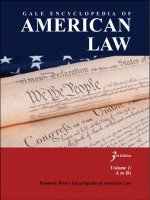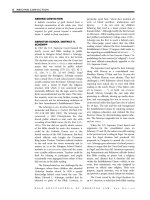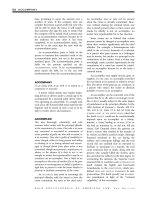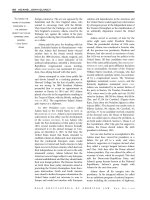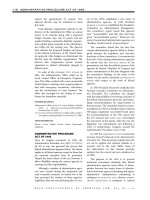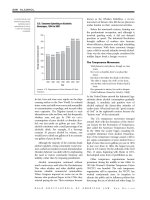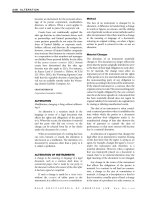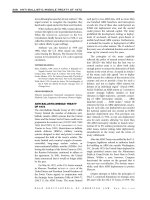Gale Encyclopedia Of American Law 3Rd Edition Volume 3 P23 pps
Bạn đang xem bản rút gọn của tài liệu. Xem và tải ngay bản đầy đủ của tài liệu tại đây (240.89 KB, 10 trang )
Willful copyright infringement can be a
federal misdemeanor, punishable by as much as
$10,000 or one year’s imprisonment. Criminal
prosecutions on this ba sis require that infringe-
ment be for the “purposes of commercial
advantage or private financial gain” (17 U.S.C.A.
§506[a]). Criminal prosecutions for copyright
infringement are generally rare. Nevertheless,
PIRACY of music and motion picture record-
ings—in which criminals mass-produce such
recordings without permission and without
paying royalties—has become increasingly com-
mon. This fact led to the passage of the Piracy
and Counterfeiting Amendments Act of 1982 (18
U.S.C.A. § 2318), which allows punishment of up
to $250,000 in fines or five years in prison for
pirating one thousand phonorecords or 65 films
within 180 days. The fraudulent use or removal of
copyright notices is also a punishable offense.
Fair Use
Fair use is a judicial doctrine that refers to a use
of copyrighted material that does not infringe
upon or violate the exclusive rights of the
copyright holder. Fair use is an important and
well established limitation on the exclusive right
of copyright owners. Examples of fair use
include the making of Braille copies or audio
recordings of books for use by blind people and
the making of video recordings of broadcast
television programs or films by individuals for
certain private, noncommercial use.
Examples of fair use typically involve,
according to the Copyright Act of 1976, the
reproduction of authored works for the purpose
of “criticism, comment, news reporting, teach-
ing … , scholarship, or research” (17 U.S.C.A. §
107). The same act also establishes a four-part
test to determine fair use according to the
following factors: (1) the purpose and character
of the use, including whether such use is of a
commercial nature or is for nonprofit educa-
tional purposes; (2) the nature of the copy-
righted work; (3) the amount and substantiality
of the portion used in relation to the copy-
righted work as a whole; and (4) the effect of the
use upon the potential market for, or value of,
the copyrighted work (17 U.S.C.A. § 107).
It is usually considered fair use of an
authored work to take small quotations or
excerpts and to include them in another work,
as when quotations are taken from a book and
inserted into a book review. However, courts
have found that such quotation is not fair use
when material is taken from unpublished
sources, as happened in the 1985 case Harper
& Row v. Nation Enterprises, 471 U.S. 539, 105
S. Ct. 2218, 85 L. Ed. 2d 588.
The Harper case involved publication by The
Nation magazine of quotations from Gerald R.
Ford’s unpublished memoir, A Time to Heal.
Harper & Row, publisher of the memoir, sued
The Nation, claiming that the magazine’s actions
had caused it to lose a lucrative contract with
Time Magazine to publish excerpts from the
memoir. The Court ruled in favor of Harper,
citing the economic value of first publication to
the copyright holder as an important factor in its
decision. It found that The Nation had infringed
Ford’s copyright by becoming the first publisher
of his original expression, thereby inflicting
economic losses on Ford. It rejected The
Nation’s argument that it was simply reporting
news. Lower courts have subsequently applied
the Court’s reasoning to other cases involving
quotations from unpublished works. In Salinger
v. Random House, 811 F.2d 90 (2d Cir. 1987), a
federal appeals court blocked publication of a
book that used extensive quotations from
unpublished letters of the author J. D. Salinger.
The court ruled that the author retained
copyright ownership of the “expressive content”
of the letters, even when the letters themselves
were deposited in university library collections.
Parody often constitutes fair use of copy-
righted material. In cases involving parodies of
copyrighted works, courts typically assess the
purpose and intent involved in taking material
from the original expression, and whether or
not the author of the parody has borrowed a
reasonable amount of material in producing
the parody. For example, in the 1994 case of
Campbell v. Acuff-Rose Music, 501 U.S. 569, 114
S. Ct. 1164, 127 L. Ed. 2d 500, which involved a
parody by the rap group 2 Live Crew of the Roy
Orbison song “Pretty Woman,” the U.S.
Supreme Court ruled that a parody could be
fair use under copyright law even if it is created
for commercial purposes.
Copyright Registration, Deposit,
and Notice
Registration of copyright involves recording the
existence of an authored work and the identity of
its author with the U.S. Copyright Office, which
is a part of the
LIBRARY OF CONGRESS. Deposit
involves placing the work in its recorded, physical
form with the same office. Notice, or notification,
GALE ENCYCLOPEDIA OF AMERICAN LAW, 3RD E DITION
208 COPYRIGHT
involves placing on an authored work the ª or
the word Copyright or the abbreviation Copr.,
along with the year of first publication and the
name of the owner of the copyright.
Many of the major copyright acts in U.S.
history have required that works be registered
and deposited with a U.S. district court or
with the U.S. Copyright Office, in order to be
legally enforceable. Over time, however, de-
posit, registration, and notice of copyright have
increasingly become formalities. Under the
Copyright Act of 1976, authors automatically
receive federal copyright protection when they
fix their work in a tangible medium. Even if a
copyright is not registered and an authored
work is not deposited, the author maintains
exclusive rights to the work.
Nevertheless, registration and deposit may
have significant legal consequences. Most im-
portantly, owners of copyright cannot sue for
copyright infringement until they have regis-
tered the copyright (17 U.S.C.A. § § 411, 412).
Deposit is not a requirement for copyright
protection, but federal law requires that two
copies of a published work be deposited within
three months of publication. Failure to deposit a
copy after it has been demanded by the U.S.
Copyright Office is an offense punishable by a
fine. Registration of copyright requires the
deposit of at least one copy of a work and two
copies of a published work. The U.S. Copyright
Office has the power to vary these requirements.
Copyright notice serves a number of func-
tions. A lack of copyright notice has tradition-
ally informed users that a particular work is in
the public domain, whereas the presence of a
notice has warned users that a work is copy-
righted and identifies the date and year of
the work. Despite these traditions, copyright
notice is optional for works distributed after
October 31, 1988. Under prior law, an omission
of copyright notice resulted in a loss of
copyright protection.
Digital Millennium Copyright Act
Copyright laws have had to evolve in order to
protect the interests of owners of copyrights
from in fringement through transfer of digital
copies of protected works. Internet users may
employ a myriad of methods to transmit digital
files, and much of the information contained in
these files consists of copyrighted works. Given
the sheer number of Internet users—estimated
by some at more than 500 million in 2002—and
trillions of pages on the World Wide Web,
protection of electron ic publications and media
is a global concern.
In 1998, President
WILLIAM JEFFERSON CLINTON
signed the Digital Millennium Copyright Act
(DMCA), Pub. L. No. 105-304, 112 Stat. 2860
(17 U.S.C.A. §§ 101 et seq.), into law following
a99–0 vote in the U.S. Senate. This legislation
was the focus of intense lobbying efforts on the
part of a wide range of interest groups. These
groups included telecommunications compa-
nies and online service providers; consumer-
electronics manufacturers, library, museum,
and university groups; and the publishing,
recording, film, and software industries. The
primary goal of this legislation was to adapt U.S.
copyright laws for the digital age.
Passage of the DMCA was also required for
the United States to keep pace with changes in
international copyright treaties. In December
1996 the World Intellectual Property Organiza-
tion (WIPO), an agency of the
UNITED NATIONS,
negotiated the Copyright Treaty and the Per-
formances and Phonograms Treaty at a meeting
in Geneva, Switzerland. WIPO is responsible for
the advancement and safeguarding of intellec-
tual property throughout the world, and it has
170 member countries.
The treaties, ratified in 2002, provide
increased protection for copyrighted materials
in the digital world. By signing, each country
agrees to put into place laws, based on their own
legal system, in order to enforce the treaties. The
DMCA serves that purpose for the United States.
The DMCA consists of five main sections:
WIPO Treaties Implementation, Online Copy-
right Infringement Liability Limitation, Comput-
er
MAINTENANCE or Repair Copyright Exemption,
Miscellaneous Provisions, and Protection
of Certain Original Designs. Title I, WIPO
Treaties Implementation, contains an “anti-
circumvention” provision, making it illegal to
“manufacture, import, off er to the p ublic,
provide, or otherwise traffic any technology,
product, service, device, component, or part
thereof,” for the primary purpose of “cir-
cumventing a technological measure that effec-
tively controls access to” a copyrighted work.
Thus, technologies that are designed to protect
digital material are safeguarded.
Moreover, this provision makes the act of
circumventing a “technological measure that
effectively controls access to a work protected”
GALE ENCYCLOPEDIA OF AMERICAN LAW, 3RD E DITION
COPYRIGHT 209
by copyright illegal. Every three years, the
librarian of Congress, the register of copyrights,
and the assistant secretary for communications
and information of the
COMMERCE DEPAR TMENT
must determine whether people with legitimate
noninfringing uses of copyrighted materials are
being unfavorably affected by the law. The law
does state that fair use is not affected, but this
nevertheless has been a controversial provision.
Libraries, museums, and scholars were con-
cerned about digital materials only being
available on a pay-per-use basis. An exemption
was included for nonprofit libraries, archives,
and educational institutions allowing them to
circumvent technical protection measures for
the purpose of determining whether or not to
purchase the copyrighted work.
Title I of the DMCA contains another
addition to U.S. copyright law required by the
WIPO treaties. This section prohibits the
deletion or alteration of information associated
with copyrighted material. Organizations will
benefit from this provision because it will help
protect information and images on their
Websites. Furthermore, it prohibits the distri-
bution of false copyright-management informa-
tion. The DMCA provides for civil and criminal
enforcement. However, archives, schools, non-
profit libraries, and public broadcasting stations
are exempt from criminal prosecution.
The DCMA also limits the liability for
copyright infringement by providing safe harbors
for online service providers. The definition of an
online service provider is generous. Other
organizations may qualify for protection, which
could be useful if they provide Internet access,
have a company bulletin board or in-house email
system, or chat rooms. Prior to the passage of the
DMCA, online service providers could have been
liable if infringing materials were posted on their
sites, even if they were unaware of the problem.
The DMCA explains the responsibilities of
copyright owners and service providers. Under
specific conditions, online service providers are
exempt from having to pay monetary damages as
long as they are not benefiting financially from
infringing activity and as long as they remove the
material promptly from the Internet.
Limitations have also been set on exclusive
rights for computer programs. A provision
allows users to copy programs that are needed
in order to maintain and repair a machine. Any
such copies must be des troyed as soon as the
machine is repaired, however.
One significant exemption for libraries and
archives was included in Title IV of the DMCA.
Up to three copies may be made of a copy-
righted work without the permission of the
copyright owner for research use in other
libraries or archives through interlibrary loan.
The word facsimile has been struck from the
former copyright law, thus allowing for digital
formats. Libraries and archives can now loan
digital copies of works to other libraries and
archives by electronic means. Copies for preser-
vation and security purposes are also permitted
when the existing format in which the material
is stored becomes outdated, or if the work is
lost, stolen, damaged, or deteriorating.
Title IV also established guidelines for
licensing and royalties in regard to copyrighted
music transmitted over the Internet and in other
digital forms. Transmissions are not subject to
licensing if transmitted with encoded copyright
information and with permission from the
copyright owner of the sound recording.
No Electronic Theft Act
The concerns surrounding the protection of the
copyrights of electronic data extend to comput-
er software. In 1997 Congress approved the
No Electronic Theft (NET) Act (Pub. L. No.
105-147, 111 Stat. 2678), which substantially
enhanced existing federal copyright law. Aimed
primarily at the rampant theft of computer
software, i t allows the prosecution of anyone
who violates the copyright of materials worth
more than $1,000 in a six-month period by
copying, distributing, or receiving software.
Congress passed the law in November 1997
after the software and entertainment industries
strongly lobbied for it, claiming losses amount-
ing to $2 billion in 1996 in the United States
alone. In particular, the law closed a narrow
loophole in existing federal law, which made
criminal prosecution for copyright violation
only possible if the violation resulted in
financial gain. Under the NET Act, individuals
face fines and jail sentences even if they do not
profit financially from the violation. The l aw
was enacted over protests by scientists who
feared that it would hinder their research.
Lobbyists pointed to what became known as
the “LaMaccia loophole.” This term refers to an
unforeseen weakness in federal law that was
exposed by the failed federal prosecution of
computer hacker David LaMacchia in 1994
(United States v. LaMacchia, 871 F. Supp. 535
GALE ENCYCLOPEDIA OF AMERICAN LAW, 3RD E DITION
210 COPYRIGHT
[D. Mass. 1994]). LaMacchia, then a 21-year-old
student at the Massachusetts Institute of Tech-
nology, had used an electronic bulletin board to
freely distribute countless commercial software
programs. Although he was indicted for wire
FRAUD under 18 U.S.C.A. § 1343 for allegedly
causing software companies losses of more than
$1 million, the case was dismissed. Richard
Stearns, the U.S. district court judge, ruled that
criminal sanctions did not apply because LaMac-
chia had not profited from his actions.
According to the software industry, the
decision paved the way for piracy of material
through Web pages and other commonly used
Internet sites. Software manufacturers were not
only concerned about deliberate piracy by
computer hackers; they also wanted to stop the
casual lending and copying of computer software
between consumers and within offices as well.
Joining them in this effort were the music and
film industries, which have increasingly become
partners of software companies in the production
of multimedia CD-ROMs. Additionally, the
music industry viewed with alarm the widespread
distribution of commercial recordings by fans,
which became popular over the Internet in 1997
with the development of new software technology
for digitally copying songs.
The NET Act was designed to close the
LaMacchia loophole. Swiftly passed by the House
and subsequently approved by the Senate, the act
accomplished this by amending two key parts of
federal copyright law: Titles 17 and 18 of the
United States Code. These laws previously
defined copyright violation strictly in terms of
financial gain. The NET Act broadened them to
include the reproduction or distribution of one
or more copies of copyrighted works and
considers financial gain simply to be the
possession of copyrighted work. It defines a
misdemeanor violation as occurring when the
value of the copied material exceeds $1,000 over
a 180-day period; a felony occurs if the value
exceeds $2,500. Penalties range from a one-year
jail sentence and up to $100,000 in fines for first-
time offenders to five years’ imprisonment and
up to $250,000 in fines for repeat offenders.
FURTHER READINGS
Electronic Frontier Foundation. 1995. To Have and to Hold:
Can Copyrights Extend to Cyberspace without Increased
Costs and Threats to Privacy? (June 8).
Goldstein, Paul. 2003. Copyright’s Highway: From Gutenberg
to the Celestial Jukebox. Rev. ed. Stanford, Calif.:
Stanford Univ. Press.
LaFrance, Mary. 2008. Copyright Law in a Nutshell. St. Paul,
Minn.: Thomson/West.
Vaidhyanathan, Siva. 2001. Copyrights and Copywrongs: The
Rise of Intellectual Property and How It Threatens
Creativity. New York: New York Univ. Press.
CROSS REFERENCES
Copyright, International; Infringement; Intellectual Property;
Internet.
COPYRIGHT ARBITRATION
ROYALTY PANEL
Three-member ad hoc board empowered to make
decisions regarding ratemaking and distributions
of copyright royalties collected for compulsory
licenses under the Copyright Act of 1976.
In order for a person to use another’s
copyrighted work, the person must generally
obtain a license from the
COPYRIGHT owner. The
terms of the agreement normally depend upon
market conditions at the time of the agreement.
However, the Copyright Act of 1976, codified in
Title 17 of the United States Code, creates an
exception under some circumstances whereby a
prospective user may obtain a compulsory
license that allows the individual to use a
copyrighted work without the owner’s permis-
sion. The compulsory license applies so long as
the person applying for the license meets
statutory requirements and pays the required
royalties.
Congress in the 1976 act created the
COPYRIGHT ROYALTY TRIBUNAL (CRT), an indepen-
dent federal agency empowered to distribute
royalties collected under the compulsory license
provisions, as well as to make periodic adjust-
ments to the royalty rates attached to the
compulsory licenses. The original copyright
act provided for four compulsory licenses,
including those for
CABLE TELEVISION, musical
mechanical, noncommercial broadcasting, and
jukeboxes. In 1992 Congress extended respon-
sibility to the CRT to include distribution of
levies collected from manufacturers and impor-
ters of digital recording devices.
The Copyright Royalty Tribunal was con-
troversial from its inception. Although the
ratemaking provisions were generally clear,
the statute was rather ambiguous regarding
the methods by which the tribunal should
distribute royalties. The tribunal’s decisions
with respect to its ratemaking powers led to
frequent criticism and litigation. Moreover,
critics charged that Congress had created a
GALE ENCYCLOPEDIA OF AMERICAN LAW, 3RD E DITION
COPYRIGHT ARBITRATION ROYALTY PANEL 211
full-time independent agency to perform a part-
time job. In 1990 Congress reduced the number
of commissioners on the tribunal from five
to three, and during hearings in the House of
Representatives in 1993, two of the three
commissioners testified that they were in favor
of abolishing the Copyright Royalty Tribunal.
In 1988 Congress enacted the Satellite
Home Viewer Act, Pub. L. No. 100-667, 102
Stat. 3935, which created, at that time, a fifth
compulsory license. However, the act required
the formation of ad hoc arbitration panels to
amend royalty fees for satellite retransmissions,
thus bypassing the authority of the CRT. The
success of these arbitration panels persuaded
Congress to use them for the other forms of
compulsory licenses under the Copyright Act.
The Copyright Royalty Trib unal Reform Act of
1993, Pub. L. No. 103-198, 107 Stat. 2304,
immediately abolished the Copyright Royalty
Tribunal and allowed for the formation of ad
hoc copyright arbitration royalty panels.
The 1993 act did not change the system of
compulsory licenses, but rather it shift ed
authority from the CRT to the new panels.
Arbitrators on these panels are appointed and
convened by the librarian of Congress, who acts
on the recommendation of the Register of
Copyrights. The arbitrators must meet mini-
mum criteria set forth under the statute in order
to quality for the position.
At the time of the creation of these
arbitration panels, the librarian of Congress
was directed to adopt the rules and regulations
of the CRT in their entirety, though the CRT no
longer existed. These rules and regulations were
to remain in force until the librarian decided to
supplement or supersede them. The adoption
of the tribunal’s former rules and regulations
presented problems, however, because the 1993
act eliminated a single body—the CRT—and
replaced it with a system of ad hoc panels. In
December 1993 the librarian of Congress
adopted the former CRT rules on an interim
basis. One year later, the librarian issued new
rules governing the panels, effective January 6,
1995. Additional revisions to the rules govern-
ing the panels have also been made since the
1994 revisions.
Like the CRT, the arbitration panels make
decisions regarding distribution of royalties and
ratemaking for royalties under the compulsory
license provisions. Unlike the CRT, the
purposes of the copyright arbitration royalty
panels are set out clearly in the statute. Among
the many purposes of the panels in the statute is
the maximization of the availability of creative
works to the public; the assurance that copy-
right owners receive a fair return for their
creative works; and the guarantee that the roles
of the copyright owner and the copyright user
in the product made available to the public were
reflected. 18 U.S.C.A. § 801(b) (1998). The
statute lists other purposes as well.
The copyright arbitration royalty panels
have proven more popular than the former
CRT, although disputes still arise regarding
ratemaking or distribution decisions by the
panels. Convening a panel to make a rate
adjustment is more difficult than the procedure
that was followed under the CRT, which was a
permanent body. The time frame under which
a panel decision must be completed is also a
concern for those involved in a pane l proceed-
ing. All actions by the parties—including
discovery, testimony, studies, arguments,
motions, and so forth—as well as rulings,
orders, and final report issued by the panel,
must be completed within 180 days after the
librarian of Congress directs the formation of
the arbitration panel. Nevertheless, these pro-
cedures are generally believed to promote
efficiency when these panels make these deter-
minations, and the panels have not been
subjected to the same level of criticism as the
former tribunals.
FURTHER READINGS
Davis, Mark J. 2003. “Practice before the Copyright
Arbitration Royalty Panel in 17 U.S.C. § 111 Distribution
Proceedings.” Vanderbilt Journal of Entertainment Law
and Practice 11. Available online at derbilt.
edu/publications/journal-entertainment-technology-law/
archive/download.aspx?id=1707; website ome page:
(accessed July 16, 2009)
Goldstein, Paul. 2005. Copyright (4 Vols.). 3d ed. Clark, NJ:
Lawbook Exchange.
Nimmer, Melville B., and David Nimmer. 2003. Nimmer on
Copyright. Newark, N.J.: Matthew Bender.
CROSS REFERENCES
Copyright; Copyright, International; Copyright Society of
the U.S.A.
COPYRIGHT, INTERNATIONAL
The manner in which the exclusive rights to
reproduce and distribute copies of various intel-
lectual productions may be obta ined in foreign
countries.
GALE ENCYCLOPEDIA OF AMERICAN LAW, 3RD E DITION
212 COPYRIGHT, INTERNATIONAL
INTERNATIONAL COPYRIGHT protection can be
secured in only two ways: (1) by obta ining
separate and independent
COPYRIGHT protec-
tion in each of the countries where such
protection is sought, in compliance with the
laws of each country; or (2) through interna-
tional conventions or treaties that provide for
the mutual recognition and protection of the
literary an d
INTELLECTUAL PROPERTY of the
citizens of the natio ns that ar e partie s to such
treaties or conventions. Citizens of the United
States who seek copyright protection in foreign
countries may sometimes avail themselves of
the first me thod, somet imes the second, and
sometimes neither, depending upon the l aws
of the countries in which the foreign copy-
rights issue.
In 1989 the United States for the first time
became a signatory to the oldest and most
widely approved international copyright treaty,
the Berne Convention for the Protection of
Literary and Artistic Works (828 U.N.T.S. 221,
S. Treaty Doc. No. 99-27). In doing so, the
United States ended a long history of noncom-
pliance with the Berne Convention, finally
joining the vast majority of developed countries.
As of the mid 1990s, 96 countries had signed the
Berne Convention.
Among the works protected by the Berne
Convention are books, pamphlets, and other
printed materials; dramatic and dramatico-
musical works and musical compositions;
drawings and paintings; works of architecture,
sculpture, engraving, and lithography; illustra-
tions and geographic charts, plans, and sketches;
translations, adaptations, arrangements of mu-
sic, and collections of various works; and
cinematographic and photographic works.
History of the Berne Convention
The Berne Convention was first adopted on
September 9, 1886, in Berne, Switzerland, and
was later revised at several conferences: Pari s,
1896; Berlin, 1908; Berne, 1914; Rome, 1928;
Brussels, 1948; Stockholm, 1967; and Paris,
1971. The agreement grew out of a perceived
need in the late nineteenth century to protect
authored works from international
PIRACY,or
unauthorized copying. A growing demand for
new printed materials during this era was
motivating many publishers to reprint unau-
thorized versions of foreign works. Authors
whose works were pirated had little recourse
against those publishers because copyright laws
were typically enacted on a national basis. Such
laws gave copyright protection only to authors
who were nationals of the country in which the
laws were enacted.
A few countries negotiated bilat eral treaties—
two-party contracts termed reciprocal agree-
ments—that protected the nationals of both
countries, but such arrangements were rare. In
the mid nineteenth century, a nongovernment
organization, the Association Littéraire et Artis-
tique International, was formed in Paris and led
the movement for international copyright pro-
tection. This organization created the draft of
what eventually became the Berne Conventio n.
Among the first countries adhering to the Berne
Convention were France, Germany, and the
United Kingdom.
The Berne Convention established several
principles of international copyright that have
remained through all of the treaty’s versions.
First, rather than operating on a system of
reciprocity (under which a country protects
foreign authors only to the extent that its own
authors are protected in return), the convention
works on the principle of national treatment
(under which a country extends the same
protection to foreigners that it accords to its
own authors). Second, rather than trying to
impose the same standards on all nations, the
convention solved the problem of national
differences in copyright protection by establish-
ing minimum standards of protection that all
signatories must meet. Thus, member countries
may treat the copyrighted work of their own
nationals in any way they choose, but they must
treat works from nationals of other treaty
members according to minimum treaty stan-
dards. Third, the convention provides for auto-
matic protection of copyrighted works as soon as
they are created, without any required formalities,
such as notice or registration.
The United States and the Berne
Convention
Influenced greatly by its early status as a net
importer of copyrighted materials, the United
States resisted joining the Berne Convention for
over a century. Adherence to the treaty’s
conventions would have required U.S. publish-
ers of foreign works—many of whom produced
pirated copies—to pay royalties and fees to
foreign copyright holders, thus causing a
significant amount of money to flow overseas.
However, by the end of
WORLD WAR II, the United
GALE ENCYCLOPEDIA OF AMERICAN LAW, 3RD E DITION
COPYRIGHT, INTERNATIONAL 213
States had become a major exporter of copy-
righted materials, and it became clear that it
would be to the country’s economic advantage
if its own authors and copyright holders could
be assured of receiving royalties from overseas
publishing.
At that point, rather than joining the Berne
Convention, the United States lobbied for a
different international treaty, the Universal
Copyright Convention (UCC) (25 U.S.T. 1341,
T.I.A.S. No. 7868), established in 1952 under the
auspices of the U.N. Educational, Scientific, and
Cultural Organization (UNESCO). The United
States became a member of the UCC in 1955.
Many countries that already belonged to the
Berne Convention—including France, West
Germany, and Japan—also joined the UCC.
The UCC generally operated on the national-
treatment principle, thus allowing U.S. authors
to receive the same copyright protection in a
specific country that the country afforded its
own authors, and not requiring the United States
to reciprocate that treatment for foreign authors.
The United States experienced still more
international pressure to join the Berne Con-
vention after passage of the Copyright Act of
1976 (17 U.S.C.A. §§ 101 et seq.). This statute
brought several important features of the Berne
Convention into U.S. law, including relaxed
standards on the formalities of copyright
registration, deposit, and notice, and new
provisions that extended the duration of
copyright protection to the Berne minimum
of the author’s life plus 50 years (which has
since been extended to life plus 70 years). The
act also phased out a protectionist manufac tur-
ing clause that had required foreign works to be
set in type in the United States in order to
receive U.S. copyright protection—a clause that
had benefited U.S. printers for decades. (In fact,
lobbying by printers had long stym ied attempts
to make the United States part of the Berne
Convention.)
By the 1980s the United States was still one
of the few major developed countries not
abiding by the Berne Convention. When it
became clear that the United States’ role as a
pariah in international copyright circles had
begun to erode its position in reaching other
trade agreements concerning intellectual prop-
erty, Congress finally passed the Berne Conven-
tion Implementation Act of 1988 (Pub. L. No.
100-568, 102 Stat. 2853). That act made the
United States a party to the Berne Convention
beginning in 1989, officially ending U.S.
copyright isolationism.
Protection of Copyright
in the Digital Age
Protection of the interests of copyright owners
and enforcement of their rights has become
more difficult since the rise of
INTERNET around
the world. The World Wide Web, a component
of the Internet, consists of trillions of individual
web pages, and according to some estimates,
the number of Internet users has increased to
more than 500 million.
The Internet has created a new avenue for
copyright infringement on a global scale.
Although virtually all types of works that are
subject to copyright law can be transferred
through digital networks, transfers of music
recordings have received the most attention.
A web-based company, Napster, during the
1990s became the most well-known and heavily
used portal for transferring electronic files
containing copies of music. Users of this system
were capable of transferring copyrighted works
in a format called MP3 (MPEG-1 Audio Layer
3) to their home computers, with a sound
quality that was comparable to that of a
compact disc. The musical compositions in
most of these files were copyrighted, and
owners of those copyrighted materials com-
plained that the file transfers infringed their
copyrights. The Recording Industry Association
of America sued Napster, eventually prevailing
and causing Napster to close down. Napster was
not merely a phenomenon in the United States
and North America. The company had an
estimated 16.9 worldwide users, and the system
accommodated about 65 million downloads.
Domestic copyright law is limited in its
protection of some of these works because the
Copyright Act generally has no application
outside of the United States. For example, in
Subafilms, Inc. v. MGM—Pathe Communica-
tions Co., 24 F.3d 1088 (9th Cir. 1994), U.S.
Court of Appeals for the Ninth Circuit noted
as much in holding that a copyright holder
could no t sue individuals who distributed the
plaintiff’s movies abroad, because the infringe-
ment occurred outside of U.S. soil. Although
the Berne Convention, as well as such interna-
tional intellectual property treaties as the
Geneva Phonograms Convention, the Rome
GALE ENCYCLOPEDIA OF AMERICAN LAW, 3RD E DITION
214 COPYRIGHT, INTERNATIONAL
Convention, protects such copyrights, addition-
al protection was needed.
In 1996 the World Trade Organization
approved the Agreement on Trade-Related
Aspects of Intellectual Property Rights (TRIPS),
which requires member countries to provide
certain levels of protection for copyright holders
in their countries. Additional protection came in
the form of so-called “digital treaties” approved
by the World Intellectual Property Organization,
including the Copyright Treaty and the Perfor-
mance and Phonograms Treaty. Both of these
treaties, which became effective in 2002, clarified
and extended the Berne and TRIPS provisions
by allowing copyright holders to encrypt their
works in order to protect their rights.
COPYRIGHT ROYALTY TRIBUNAL
The Copyright Royalty Tribunal was established
by an act of October 19, 1976 (90 Stat. 2594; 17
U.S.C. 801).
The tribunal makes determinations concern-
ing the adjustment of
COPYRIGHT royalty rates for
records, jukeboxes, and certain CABLE TELEVISION
transmissions. After compulsory cable television
and jukebox royalties have been deposited with
the register of copyrights, the tribunal distributes
the fees and, in cases of controversy among
claimants, determines their distribution.
The tribunal also establishes and makes
determinations concerning terms and rates of
royalty payments for the use by public broad-
casting stations of published nondramatic
compositions and pictorial, graphic, and sculp-
tural works. Cost-of-living adjustments are
made to these noncommercial broadcasting
rates in August of each year.
Factors involved in tribunal decisions in-
clude the existence of economic conditions, the
impact on copyright owners and users and
the industry involved, and the maximization of
the availability of creative works to the public.
Recognizing the right of copyright owners to
receive a fair return, the tribunal ensures them
access to information about the use of their
works.
COPYRIGHT SOCIETY OF THE U.S.A.
The Copyright Society of the U.S.A. was
founded in 1953 to promote the protection
and study of
INTELLECTUAL PROPERTY rights in
areas such as art, literature, motion pictures,
and music. Its primary function is gathering,
disseminating, and interchanging information
concerning protection and use of copyrighted
materials. The organization undertakes and
engages in research in the field of copyright
law in cooperation with universities, law
schools, libraries, governmental agencies, law-
yers, and industry representatives in the
United States and foreign countries. It also
seeks to promote better understanding of
copyright and the vital importance of legal
and economic protection of intellectual prop-
erty in general, and copyright in particular,
among the general public, in industry, and in
theacademicworld.Italsoprovidesinforma-
tion to the public through its web site, http://
www.csusa.org.
To accomplish its goals, the society has
undertaken a wide-ranging program including
symposia on copyright subjects; work shops for
people in such fields as music, motion pictures,
and publishing, stressing the practical aspects
and mechanics of copyright administration; and
publication of materials relating to copyright
that otherwise would not be available. Its
members are lawyers, laypersons, firms, librar-
ies, universities, and publishers. The society
publishes a journal and holds annual meeti ngs.
In 2001 it launched its Copyright Kids web
site (), a compre-
hensive resource for school-age children that
explains copyright facts and regulations and
answers questions about the importance of
copyright protection.
CORAM
[Latin, Before; in the presence of.]
The term coram is used in phrases that refer
to the appearance of a person before another
individual or a group. Coram non judice, “in the
presence of a person not a judge,” is a phrase
that describes a proceeding brought before a
court that lacks the jurisdiction to hear such a
matter. Any judgment rendered by the court in
such a case is void.
CORAM NOBIS
[Latin, In our presence; before us.] The designa-
tion of a remedy for setting aside an erroneous
judgment in a civil or criminal action that resulted
from an error of fact in the proceeding.
GALE ENCYCLOPEDIA OF AMERICAN LAW, 3RD E DITION
CORAM NOBIS 215
In civil actions, a petition for a writ of
coram n ob is was addressed to the court in
which the judgment was made, unlike an
appeal, which is made to a superior court.
The petition asserted that the court had made
an erroneous judgment due to the defendant’s
excusable failure to make a valid defens e as a
result of
FRAUD, duress, or excusable neglect,
such as illness. Coram nobis could not be used
where a party caused an error because of
NEGLIGE N C E .
The writ of coram nobis has been abolished
in civil actions by the rules of federalcivil
procedure and similar provisions of state codes
of
CIVIL PROCEDURE that, instead, establish differ-
ent methods for setting aside judgments.
In
CRIMINAL PROCEDURE, coram nobis serves
the same purpose as it did in civil actions and is
a recognized procedure in federal criminal
prosecutions. Traditionally, it was available to
direct the court’s attention to information that
did appear in the trial record and was not
admitted into evidence because of fraud, duress,
or excusable mistake. A
DEFENDANT could not use
coram nobis to relitigate the same charges if,
through his or her own fault, such facts were
not introduced as evidence.
Modern statutes have expanded the grounds
for relief based upon the principles derived
from the ancient writ of coram nobis. It is no
longer a common-law remedy, but statutes
provide for the vacation of a conviction and
usually order a new trial if there is insufficient
evidence to sustain the conviction, newly
discovered evidence, erroneous instruction to
the jury, or prejudicial comments or conduct by
the prosecutor during the trial.
CORAM REGE
[Latin, In the presence of the king himself.]
After the Norman Conquest of England in
1066, court was held before the king himself—
coram rege—whenever matters affecting the
royal interest were in issue. When the king
began to appoint a tribunal to hear cases for
him, it was called the
CURIA REGIS, or the King’s
Court. From the Curia Regis developed the
royal
COMMON-LAW COURTS.
v
CORBIN, ARTHUR LINTON
Arthur Linton Corbin was a leading legal
scholar and professor who made significant
and influential contributions to the develop-
ment of U.S. contract law.
Corbin was born October 17, 1874, in
Cripple Creek, a small mining town near
Colorado Springs. He was raised in Cripple
Creek and then left Colorado to attend the
University of Kansas, from which he graduated in
1894. He went on to the Yale Law School,
graduating magna cum laude in 1899. After
several years of practicing law and teaching high
school back in Cripple Creek, he returned to Yale
in 1903 to accept a position as an instructor in
contracts. He became a full professor in 1909 and
remained at Yale until his retirement in 1943 at
the age of 68.
During his tenure at Yale, Corbin played a
major role in establishing the institution as a
major national law school and center for legal
scholarship. He was instrumental in recruiting
more highly qualified students to the school by
convincing the administration to tighten admis-
sion standards. He also drew praise for his
efforts to persuade the school to hire and
Arthur Linton Corbin 1874–1967
▼▼
▼▼
18501850
19001900
19251925
19501950
19751975
18751875
◆◆◆◆◆◆◆ ❖❖
1861–65
U.S. Civil War
1874 Born,
Cripple Creek, Colo.
1894
Graduated
from the
University
of Kansas
1899 Graduated from Yale Law School
1903 Joined Yale
Law School Faculty
1909 Made
full professor
at Yale
1914–18
World War I
1932
Restatement
of Law,
Contracts,
published
1943 Retired from Yale Law School
1939–45
World War II
1950–53
Korean War
1961–73
Vietnam War
1967 Died,
New Haven, Conn.
1950 Corbin
on Contracts
first published
GALE ENCYCLOPEDIA OF AMERICAN LAW, 3RD E DITION
216 CORAM REGE
maintain a full-time faculty that would be
committed to teaching and writing, instead of
relying on judges and practicing lawyers who
taught only part-time and thus were not alw ays
available to students. In addition, Corbin helped
to implement the
CASE METHOD of teaching at
Yale, in which students glean the principles of
law through the study of cases rather than
simply by rote without reference to
COMMON LAW
as developed by the courts. Corbin was a
popular and committed teacher, even filling in
as a writer and editor for the Yale Law Journal
when the First World War left a serious
shortage of student editors and contributors.
Corbin made his greatest contribution to
contemporary legal thought through his exten-
sive and widely studied writings on the law of
contracts. He authored many books and articles
on the subject and served as adviser to the
reporters of the first and second Res tatement of
Contracts, treatises designed to set forth and
analyze the relevant principles governing con-
tract law. Corb in is best known for his own
eight-volume treatise on contracts, Corbin on
Contracts: A Comprehensive Treatise on the
Working Rules of Contracts Law, which was first
published in 1950, seven years after his retire-
ment from Yale Law School. Corbin kept his
work up-to-date until his death, through his
own revisions and by adding new material to
“pocket parts” at the back of each volume.
Corbin on Contracts quickly became a classic in
the field for practicing attorneys and is still
considered essential reading for students of
contract law.
Corbin ascribed to a “realist” philosophy in
his legal writings and thought. He believed that
the law is a critical part of everyday life and that
resulting rules governing conduct had to reflect
a changing social context. He wrote,
Law does not consist of a series of unchange-
able rules or principles…. Every system of
justice and of right is of human develop-
ment, and the necessary corollary is that no
known system is eternal. In the long history
of the law, one can observe the birth and
death of legal principles…. The law is merely
part of our changing civilization.
In 1954, on his 80th birthday, Corbin
reiterated his belief that law is inextricably tied
to human experience, stating that the “develop-
ment of our law—common, statutory, and
constitutional—is part of the continuing evolu-
tionary development of life in society.”
Corbin’s legal realist views are strongly
evident in his approach to contract law. The
main purpose of a contract, he stated in his
treatise, is “the realization of reasonable expec-
tations that have been induced by the making of
a promise.” Reasonableness, he maintained, is
an expression of customs and mores, which in
turn could be discerned from what he called the
operative facts of judicial decisions. To solve a
contractual dispute, Corbin believed, a judge
should first determine the intention of the
parties, and thus the terms of the promise or
agreement; then analyze the intention in terms
of reasonableness; and finally apply rules,
doctrines, or other principles to determine what
remedy should be offered. Above all, Corbin
believed that the reasonable expectations of the
parties should be protected. Thus, according to
Corbin, even if the price term were left open in an
agreement that otherwise had been concluded,
the court should consider whether the parties
had intended to be bound by the contract. The
court, he maintained, should make every effort to
fill in the gaps of an agreement by looking to
reasonable terms consistent with what the parties
had previously agreed upon. The contract should
fail only if it appears that the parties did not
intend to be bound, or if reasonable terms cannot
be ascertained.
Corbin further believed that in resolving
contractual disputes, courts should not be
limited to a contract’s “four corners” (the
explicit terms of the agreement) or to the
“plain meaning” of those terms. The parties’
intent should be gleaned from what they stated
and from their conduct; their prior
COURSE OF
DEALING
, trade practices, or any other pertinent
circumstances also should be considered. Cor-
bin’s views are evident in the
UNIFORM COMMER-
CIAL CODE
, adopted in 49 states, and in the law of
contracts as developed by the courts since the
mid 1900s.
Corbin’s views often stand in contrast to
those of another leading American scholar in
contracts,
SAMUEL WILLISTON. Williston sub-
scribed to the theory of legal formalism, which
views the law as a body of scientific rules from
which legal decisions can be readily deduced.
Legal formalism dominated legal thought in the
early twentieth century, and those who advo-
cated its application viewed law as essentially
conservative. Williston applied many of his
theories in the first Restatement of Contracts,
which the American Law Institute completed in
WHERE NEITHER
CUSTOM NOR
AGREEMENT
DETERMINES THE
ALLOCATION OF RISK
,
THE COURT MUST
EXERCISE ITS EQUITY
POWERS AND PRAY
FOR THE WISDOM OF
SOLOMON.
—ARTHUR CORBIN
GALE ENCYCLOPEDIA OF AMERICAN LAW, 3RD E DITION
CORBIN, ARTHUR LINTON 217
